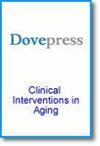缺血性脑卒中溶栓患者体内酸性纤维蛋白和神经球蛋白的表达
IF 3.7
3区 医学
引用次数: 0
摘要
目的:胶质纤维酸性蛋白(GFAP)和神经球蛋白(NGB)是脑缺氧的重要生物标志物。为此,我们尝试评估它们在不同时间间隔内的浓度及其对溶栓治疗缺血性脑卒中患者神经症状严重程度和功能预后的影响:本研究涉及在中风症状出现后 4.5 小时内到比得哥什大学医学院附属医院急诊科就诊的 94 名患者。使用商业 ELISA 试剂盒在指定时间测量血浆中的 GFAP 和神经球蛋白水平:根据收集到的数据,中风患者和对照组的生物标志物浓度在统计学上存在显著差异。缺血性脑卒中患者体内 GFAP 和 NGB 这两种生物标志物的浓度均升高,而且它们在脑卒中后续阶段的浓度变化可能表明它们的预后价值严格依赖于时间。NGB 在第 7 天测定,而 mRS 则在一年后测定(0.35)。24 小时后和第 7 天测量的 GFAP 可作为一年后功能预后(临界点≤ 0.231 ng/mL,灵敏度 75.0%,特异性 61.2%;临界点≤ 0.235 ng/mL,灵敏度 75.0%,特异性 73.9%)和患者神经状况严重程度的生物标志物。在 24 小时内测量的 GFAP 浓度超过 0.25 纳克/毫升时,中风患者的死亡率急剧上升。就 NGB 而言,在中风发生时(14 纳克/毫升)和 24 小时后(10- 60 纳克/毫升)。这些生物标志物的浓度在不同的中风亚型中存在差异:结论:NGB 和 GFAP 是缺血性脑损伤的重要生物标志物,也可用于预测神经系统的预后:GFAP、NGB、中风、氧化应激、炎症、溶栓本文章由计算机程序翻译,如有差异,请以英文原文为准。
Expression of Acidic Fibrillar Protein and Neuroglobin in Thrombolytic Patients in Ischemic Stroke
Purpose: Glial fibrillary acidic protein (GFAP) and neuroglobin (NGB) are important biomarkers of cerebral hypoxia. For this reason, an attempt was made to assess their concentrations in various time intervals and their impact on the severity of neurological symptoms and functional prognosis of thrombolytic ischemic stroke patients.
Patients and Methods: The study involved 94 patients reporting to the emergency department of the Collegium Medicum University Hospital in Bydgoszcz within < 4.5 hours of the onset of stroke symptoms. GFAP and neuroglobin levels were measured in plasma at indicated times using a commercial ELISA kit.
Results: Based on the data gathered, statistically significant differences were found between the concentration of biomarkers in stroke patients and the control group. The concentrations of both biomarkers, GFAP and NGB, were elevated in patients after ischemic stroke and the changes in their concentrations in the subsequent stages of stroke may suggest their prognostic value strictly dependent on time. NGB was determined on the 7th day, and mRS - after a year (0.35). GFAP measured after 24 h and on day 7 could be a promising biomarker of functional outcome after one year (cut-off point ≤ 0.231 ng/mL, sensitivity 75.0%, specificity 61.2%, cut off point ≤ 0.235 ng/mL, sensitivity 75.0%, specificity 73.9%, respectively) and the severity of the patient’s neurological condition. At GFAP concentrations above 0.25 ng/mL, measured within 24 hours, a sharp increase in mortality was observed in stroke patients. In the case of NGB, at the time of stroke occurrence (14 ng/mL) and after 24 hours (10– 60 ng/mL). Differences in the concentrations of these biomarkers have been demonstrated in different stroke subtypes.
Conclusion: NGB and GFAP are important biomarkers of ischemic brain injury and may also participate in predicting neurological outcomes.
Keywords: GFAP, NGB, stroke, oxidative stress, inflammation, thrombolysis
Patients and Methods: The study involved 94 patients reporting to the emergency department of the Collegium Medicum University Hospital in Bydgoszcz within < 4.5 hours of the onset of stroke symptoms. GFAP and neuroglobin levels were measured in plasma at indicated times using a commercial ELISA kit.
Results: Based on the data gathered, statistically significant differences were found between the concentration of biomarkers in stroke patients and the control group. The concentrations of both biomarkers, GFAP and NGB, were elevated in patients after ischemic stroke and the changes in their concentrations in the subsequent stages of stroke may suggest their prognostic value strictly dependent on time. NGB was determined on the 7th day, and mRS - after a year (0.35). GFAP measured after 24 h and on day 7 could be a promising biomarker of functional outcome after one year (cut-off point ≤ 0.231 ng/mL, sensitivity 75.0%, specificity 61.2%, cut off point ≤ 0.235 ng/mL, sensitivity 75.0%, specificity 73.9%, respectively) and the severity of the patient’s neurological condition. At GFAP concentrations above 0.25 ng/mL, measured within 24 hours, a sharp increase in mortality was observed in stroke patients. In the case of NGB, at the time of stroke occurrence (14 ng/mL) and after 24 hours (10– 60 ng/mL). Differences in the concentrations of these biomarkers have been demonstrated in different stroke subtypes.
Conclusion: NGB and GFAP are important biomarkers of ischemic brain injury and may also participate in predicting neurological outcomes.
Keywords: GFAP, NGB, stroke, oxidative stress, inflammation, thrombolysis
求助全文
通过发布文献求助,成功后即可免费获取论文全文。
去求助
来源期刊

Clinical Interventions in Aging
GERIATRICS & GERONTOLOGY-
CiteScore
6.20
自引率
2.80%
发文量
193
期刊介绍:
Clinical Interventions in Aging, is an online, peer reviewed, open access journal focusing on concise rapid reporting of original research and reviews in aging. Special attention will be given to papers reporting on actual or potential clinical applications leading to improved prevention or treatment of disease or a greater understanding of pathological processes that result from maladaptive changes in the body associated with aging. This journal is directed at a wide array of scientists, engineers, pharmacists, pharmacologists and clinical specialists wishing to maintain an up to date knowledge of this exciting and emerging field.
 求助内容:
求助内容: 应助结果提醒方式:
应助结果提醒方式:


